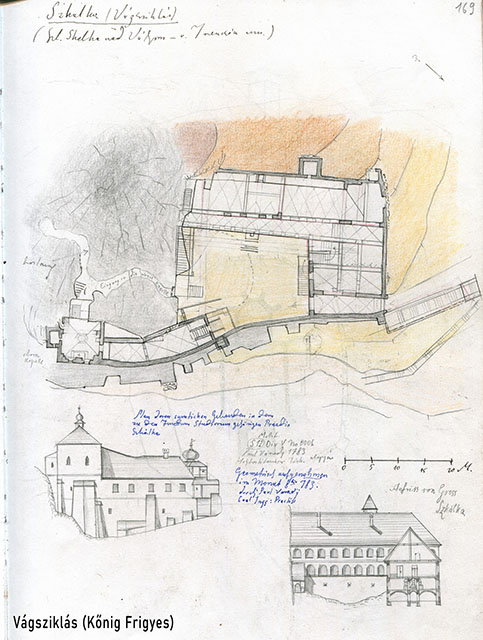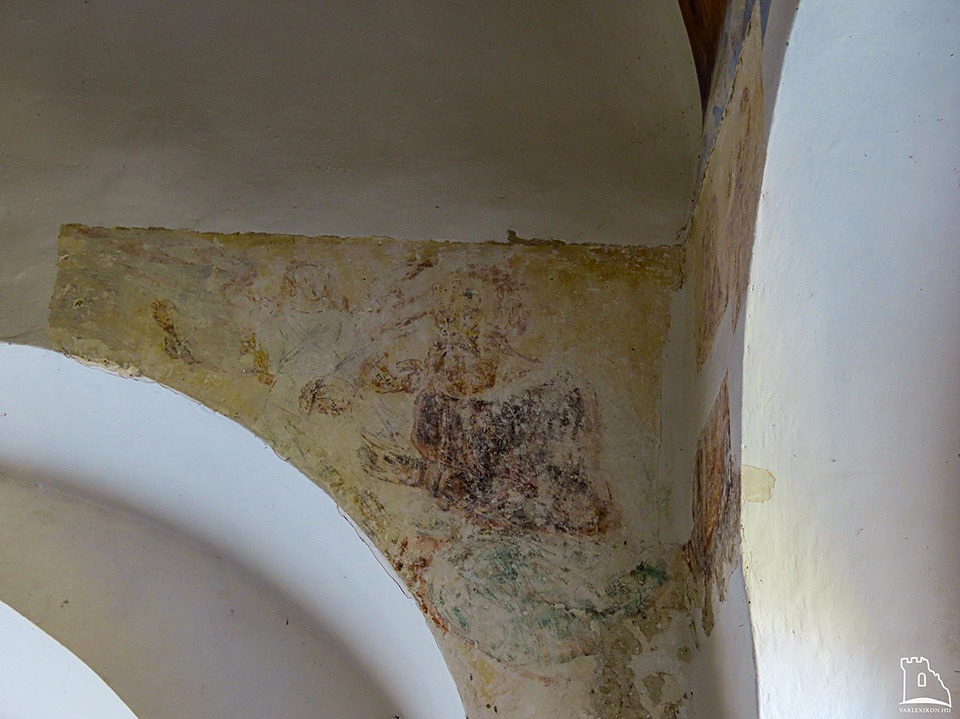
Vágsziklás (until 1899 Szkalka, in Slovak Skalka nad Váhom) is a village in the district of Trencsén (Trenčín), Slovakia. It includes the villages of Nemesújfalu and Vágutas. It is the oldest pilgrimage site in present-day Slovakia, famous for its fortified monastery.

During the reign of King István of Hungary, the Polish-born Saint Zoerard/András, a member of the Zobor Hill Abbey near Nyitra (Nitra), left the monastery with the permission of Abbot Fülöp and became a hermit, first on the Zobor Hill and then in the cave above the Vág Valley, on Vágsziklás. He died around 1010 or 1030. Zoerard/András was visited several times by his disciple Benedek in his cave in Vágsziklás.

After his master’s death, Benedek moved into the cave, where he was attacked and killed by robbers. His body was thrown into the Vág River, where it was later found under the sign of an eagle. The bodies of Zoerard/András and Benedek were buried in St. Emmeram’s Cathedral in Nyitra and canonized in 1083. They were the first canonized saints of the Kingdom of Hungary. Their legend was written by Bishop Mór of Pécs.

In 1224, Bishop Jakab of Nyitra (“Iacobus, Dei gratia, Nitriensis Episcopus”) founded a Benedictine abbey near the hermitage of Szkalka (“et in spelunca, quae vulgo Szkalka dicitur”). In 1238, King Béla IV of Hungary donated part of the Geszte estate (“Terra Gezte”) to the “monasterio de Szkalka”.

According to the charter of King Béla IV, in 1241 Bogomér, the son of Szoboszló, who had escaped wounded from the battle of Muhi, defended the castle against the Mongol Tatars of Bajbár, who were invading from the direction of Moravia. During the fighting, the nearby monastery was probably plundered by the Tartars.

On 3 March 1318, Bishop János of Nyitra in Kalocsa recorded the crimes of the excommunicated ex-Palatine [Csák] Máté: he occupied the bishop’s town of Nyitra, took away its goods, burnt down the whole town with the canons’ houses, destroyed its walls and towers, causing damage amounting to 2,000 marks. He then listed the plundering of the bishopric at length. The document also mentioned the Szkalka monastery and its abbot:

“The castellan Dénes of Zucchan [Sucsány] took half of …… in Scala, took 2 horses belonging to a bishop’s serf of Scala…”. Abbot István of Scala was excommunicated by the bishop because he served [the sacraments] to the excommunicated [Csák] Máté in an unsafe place, and still does so, defending, supporting and inciting [Máté] against the bishop. According to the bishop’s charter, the bodies of the martyrs St. Zoerardus and St. Benedek were burned when the castle of Nyitra was burnt down.

During the construction work around the turn of the 13th and 14th centuries, the entrance to the cave was fitted with the Gothic doorframe still visible today.

On May 3, 1328, King Károly Róbert confirmed, at the request of the abbot, the previous charter issued by King Béla IV on June 23, 1238, in favor of the Basan brothers, in which they were granted a part of an estate in Geztee in Trencsén County, inhabited by “hospes” (settlers). The document was issued under its new and authentic double seal.

On the other hand, we have the privileged charter of Bishop Paskasius of Nyitra from 1297, which contained the transcription of the privileged charter of Bishop Jakab of Nyitra from 1224.
This document of 1297 also contained an addition to the charter, according to which the said Bishop Jakab subsequently exchanged the tithe of his bishopric for the tithe of the people of the abbey, which had been transferred to the monastery.

On 18 February 1342, the papal tithe collector Péter, son of Geruasius, collected 8 Viennese denarii from the abbot of Scala in the diocese of Nitra, in return for the six-year tithe from the monastery’s income. In 1348 Syffridus became abbot of the church of St Benedek of Scala.

According to a document from 1415, János was the abbot of St. Benedek’s Abbey in Scala, and Brother Mátyás was also mentioned. In 1421 the abbey was attacked by the Bohemian Hussites (* other sources say it was in 1426). During the Hussite wars, there were several raids in the Trencsén region. In 1457 Imre Szulyói was the abbot of Szkalka.

During a visitation of the Benedictine Abbey of Szkalka in 1508, the visitation of the order found it without an abbot. The abbey was inhabited by two monks, a Benedictine and a Cistercian, and the income of the abbey was enjoyed by a lay priest (Rosoni Mihály). The visitation also mentioned 2 hook guns, perhaps indicating a minimal fortification. In that year, Bishop Podmaniczky János of Nyitra gave the Abbey a quarter of the wine and grain tithes from his estates in Trencsén County.

According to a document of the Nyitra Charter dated 31 March 1515, Abbot Elek of Szkalka (Alexi us abbas de Zkalka) committed an act of plunder on the Boleso estate of Podmaniczky Mihály. In 1528 Katzianer, a general of King Ferdinand, captured the castle of Trencsén, which belonged to King Szapolyai János. During the siege, he also expelled the Benedictine monks from the Vágsziklás monastery. In the same year, Bishop Podmaniczky was granted the right of the diocese (he crowned Ferdinand I). In 1553, Thurzó Ferenc exercised the rights of the diocese. Pálffy Mátyás, archabbot of Pannonhalma, tried in vain to regain Szkalka in the middle of the 16th century.

The monastery, abandoned by the monks, was probably fortified in the second half of the 16th century. In 1644 Bishop Püsky János of Nyitra founded a Jesuit college in Trencsén. In 1645 he gave them the ruins of the Szkalka Abbey. They renovated the monastery and the adjoining buildings and used them as a summer residence.

The Jesuit Order was dissolved by Pope Clement XIV in 1773, and this was also proclaimed in Hungary by Maria Theresa, who transferred the administration of the movable and immovable property of the dissolved monasteries to the Hungarian Chamber.

Mednyánszky Alajos described it as partially ruined during his journey along the river Vág in 1824. In 1852-53 the abbot of Trencsén restored the monastery buildings. On 20 June 1880, the Hungarian Ministry of Public Education placed the buildings at the disposal of the Study Fund established for the maintenance of state Catholic schools.

Art historian Divald Kornél’s description from the early 1900s: “Ruined monastery: The ruins of the Benedictine abbey founded in 1224 on the site of the hermitage of Saints Benedek and Zoerard, radically rebuilt in the 17th century and abandoned from 1773, built 1 km from the above church ruins on the rocky slope next to the cave. The ruins are the remains of a 17th-century building enclosing a rectangular courtyard.

On the south side of the courtyard is a rock wall with a corridor carved into the rock, with a doorway with an ogival arch, a grooved frame, and a lintel. The corridor leads to a more recent chapel, which is a triple chapel, with three rooms underneath each other. The upper one has pointed arch windows, a recent oil painting of the Martyrdom of St. Zoerard in the frame of its 17th-century wooden altar, and on either side of the chapel, in the corners, a pair of 17th-century caryatid angels carved in wood between acanthus wreaths.

From the upper chapel, a long rocky corridor leads up the hill, at the end of which is a 17th-century stone carving of a seated statue of St Benedek the Martyr. From the upper chapel, a staircase leads down to the central chapel, a rectangular room with a domed vault and semi-circular windows. The lower chapel is bell-shaped, with a small cave on the south side containing the body of Christ, an 18th-century wood carving. In the outer corner of the west side of the monastery tower is a belfry with a more recent bell. “

Source: http://www.varlexikon.hu
Dear Readers, I can only make this content available through small donations or by selling my books or T-shirts:
Please, support me with a coffee here: https://www.buymeacoffee.com/duhoxoxa
You can check out my books on Amazon or Draft2Digital, they are available in hardcover, paperback, or ebook:
https://www.amazon.com/dp/198020490X or at https://books2read.com/b/boYd81

My work can also be followed and supported on Patreon: Become a Patron!http://Become a Patron!
Become a Patron! and donations can be sent by PayPal, too: https://shorturl.at/qrQR5


https://hungarianottomanwars.myspreadshop.com/all
Subscribe to my newsletter here: https://shorturl.a
Here are more pictures of Vágsziklás:






























